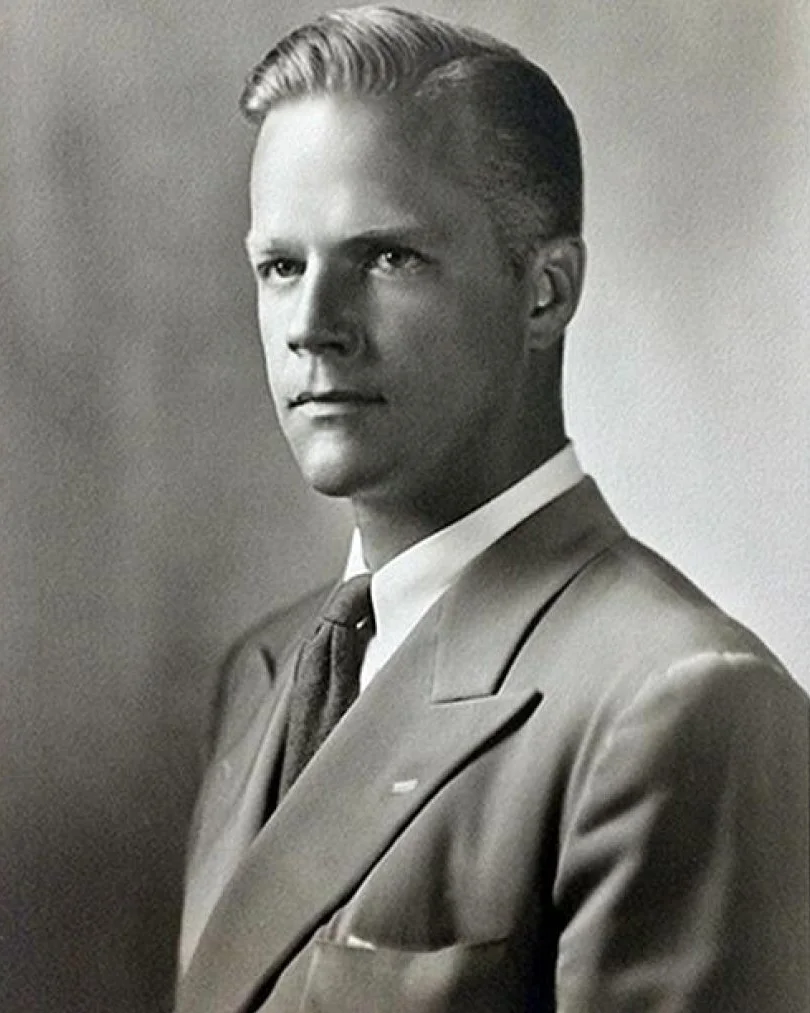Alexander Bonnyman Jr
Alexander was born in Atlanta, Georgia, on the 2nd of May, 1910, but his family moved to Knoxville, Tennessee when he was still an infant. When he was attending Princeton University, he studied engineering and also played football, though he dropped out after his sophomore year and joined the US Army Air Corps. After three months, he had been discharged for flying deficiency by September of 1932 and went to work in the coal industry, where his father had been the president of the Blue Diamond Coal Company in Knoxville. Alexander then moved to New Mexico and started a copper mining business.
When World War 2 began, Alexander was exempt from military service due to running a company that produced vital materials for the war effort. This did not stop him from enlisting and this time it was with the US Marine Corps and he went through recruit training as a Private at the Marine Corps Recruit Depot in San Diego, California. Soon after, Alexander was deployed to the South Pacific as a part of a Marine pioneer unit, similar to an Army combat engineer group. He fought in the Battle of Guadalcanal and based on his leadership skills, he received a battlefield commission to Second Lieutenant in February of 1943. Nine months later, Alexander's leadership skills would be put to the test when he landed on the beach at Tarawa and it was his actions that would not only cost him his life but earn him the Medal of Honor. The citation reads:
For conspicuous gallantry and intrepidity at the risk of his life above and beyond the call of duty as Executive Officer of the 2d Battalion Shore Party, 8th Marines, 2d Marine Division, during the assault against enemy Japanese-held Tarawa in the Gilbert Islands, 20–22 November 1943. Acting on his own initiative when assault troops were pinned down at the far end of Betio Pier by the overwhelming fire of Japanese shore batteries, 1st Lt. Bonnyman repeatedly defied the blasting fury of the enemy bombardment to organize and lead the besieged men over the long, open pier to the beach and then, voluntarily obtaining flame throwers and demolitions, organized his pioneer shore party into assault demolitionists and directed the blowing of several hostile installations before the close of D-day. Determined to effect an opening in the enemy's strongly organized defense line the following day, he voluntarily crawled approximately 40 yards forward of our lines and placed demolitions in the entrance of a large Japanese emplacement as the initial move in his planned attack against the heavily garrisoned, bombproof installation which was stubbornly resisting despite the destruction early in the action of a large number of Japanese who had been inflicting heavy casualties on our forces and holding up our advance. Withdrawing only to replenish his ammunition, he led his men in a renewed assault, fearlessly exposing himself to the merciless slash of hostile fire as he stormed the formidable bastion, directed the placement of demolition charges in both entrances and seized the top of the bombproof position, flushing more than 100 of the enemy who were instantly cut down, and effecting the annihilation of approximately 150 troops inside the emplacement. Assailed by additional Japanese after he had gained his objective, he made a heroic stand on the edge of the structure, defending his strategic position with indomitable determination in the face of the desperate charge and killing 3 of the enemy before he fell, mortally wounded. By his dauntless fighting spirit, unrelenting aggressiveness and forceful leadership throughout 3 days of unremitting, violent battle, 1st Lt. Bonnyman had inspired his men to heroic effort, enabling them to beat off the counterattack and break the back of hostile resistance in that sector for an immediate gain of 400 yards with no further casualties to our forces in this zone. He gallantly gave his life for his country.
Betio Island was secured that day and of the twenty-one Marines in the assault party, thirteen had survived. Alexander's twelve year old daughter, Frances, received his Medal from the Secretary of the Navy four years after the battle. At the time, Alexander's remains were deemed non recovered by the Defense Missing Personnel Office and later the Graves Registration Service recorded him as being buried at sea. Thanks to a Florida based non-profit called History Flight, Alexander's remains, along with thirty-five other Marines, were found in March of 2015 in a battlefield cemetery that's location had been lost by the end of the War. Alexander's grandson, Clay Bonnyman Evans, was volunteering with History Flight when his remains were exposed on the 28th of May, 2015. He went on to write a book, Bones of My Grandfather: Reclaiming a Lost Hero of World War II, which contains photographs of the recovery process. The bodies recovered from that cemetery were welcomed home to the Joint Base Pearl Harbor-Hickam in Honolulu, Hawaii on the 26th of July, 2015 and Alexander Bonnyman Jr was returned home to Knoxville, where he was buried with full military honors and a missing man Marine Corps Cobra helicopter formation on the 27th of September, 2015. He is buried next to his parents and siblings in the Berry Highland Memorial Cemetery in Knoxville, Tennessee: Section 18.




